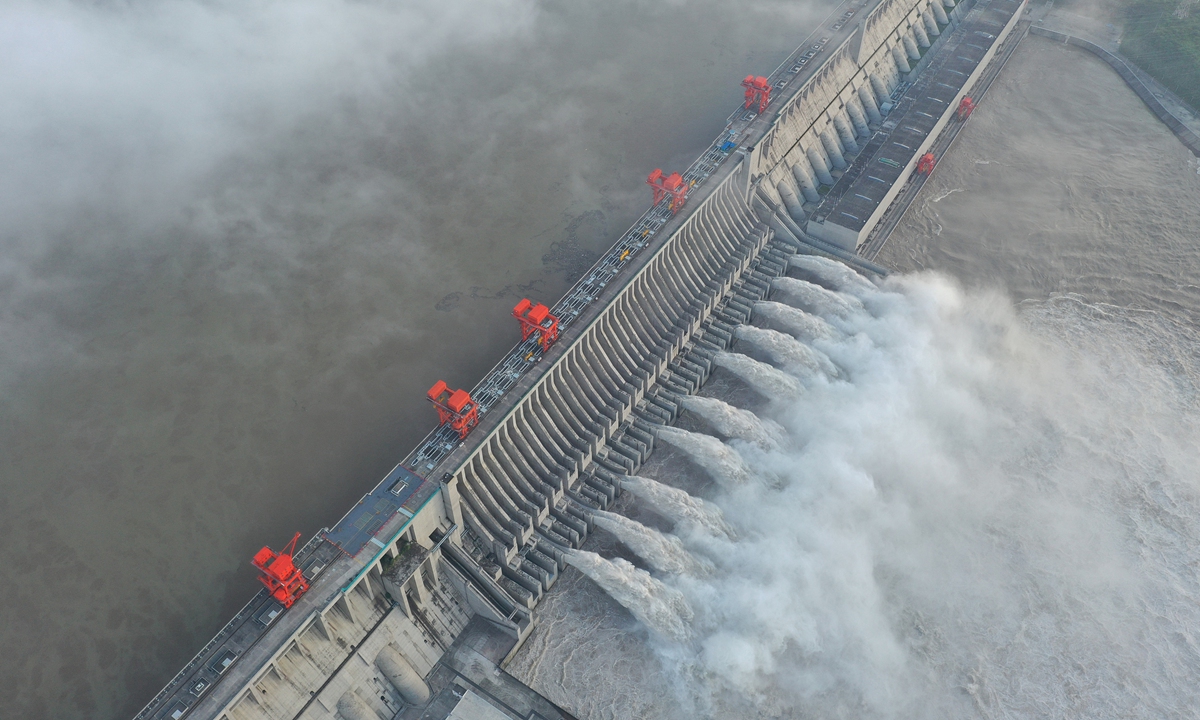Three Gorges Dam to face historic flood peak
By Zhang Han and Shan Jie Source: Global Times Published: 2020/8/19 19:21:41

Three Gorges Dam. Photo: VCG
The Three Gorges Reservoir is set to receive the largest flood peak since it was built in 2003, but experts noted that despite extreme weather conditions, China is better-prepared to minimize the impact of any natural disaster.
The latest hydrometeorological forecasts estimated the inflow flood peak of the Three Gorges project will reach 73,000 cubic meters per second at 8 am on Thursday, the largest volume since it was built in 2003.
To confront the peak, dams in the upstream of the Yangtze River — including the Wudongde, Xiluodu and Xiangjiaba dams, also managed by the Three Gorges Corp — will work together under an "elaborate deployment and operation" plan to jointly retain the flood, the Three Gorges Corp said in a statement it sent to the Global Times on Wednesday.
The dams will sufficiently carry out the flood defense function of a cascade reservoir within the basin, and they are expected to ease the flood defense pressure for Southwest China's Sichuan Province and Chongqing Municipality, as well as the Three Gorges project, according to the statement.
The discharge flow of the Three Gorges project will increase to 46,000 cubic meters per second from 42,000.
Water conservation experts noted the arrangement by the dams will disperse flood control pressure to prevent a super-large flood peak from causing a catastrophe for cities along the river.
The Three Gorges Project attracts lots of attention, but preparation for any upcoming flood peak is achieved via meticulous coordination of multiple water conservation projects along the Yangtze as well as its tributaries, Gao Jianguo, a member of the expert committee with the National Commission for Disaster Reduction, told the Global Times on Wednesday.
The US media outlet Voice of America in a Tuesday report claimed that China's floods and droughts were the results of economic development, which analysts slammed as ridiculous as it showed ignorance in meteorological phenomena, natural disasters and disaster losses.
China, with its monsoon climate, has always been troubled by floods and droughts. One description in Chinese history of the Yellow River, another major river in the country, was "breaching twice in three years, changing course every century."
Climate change has generated some extreme weather conditions, and media coverage has created the impression of floods becoming worse year after year, Gao said, noting that in regard to the impact of disasters, China now performs better in disaster relief with more accurate weather forecasts and effective emergency responses.
"We can now better predict where and when rain will fall and evacuate people beforehand," Gao said, noting that a "life first" strategy in disaster relief has reduced casualties.
China has experienced unusual rainfall in 2020 with a prolonged wet season and heavier precipitation, mainly in southern China. Rain volumes in the Yangtze and Huaihe River basins are the highest since 1961.
China also saw a 55 percent drop in flood-related deaths and missing people, and a 65 percent drop in home collapses from five years ago, according to data from the Ministry of Emergency Management.
Rapid post-disaster measures, such as draining floods and replanting crops, also help affected farmers to avoid losing their income, analysts said, citing East China's Jiangxi Province as an example.
Poyang Lake in Jiangxi experienced severe floods in July, but late-season rice is being planted to offset losses.
Posted in: SOCIETY,ENVIRONMENT